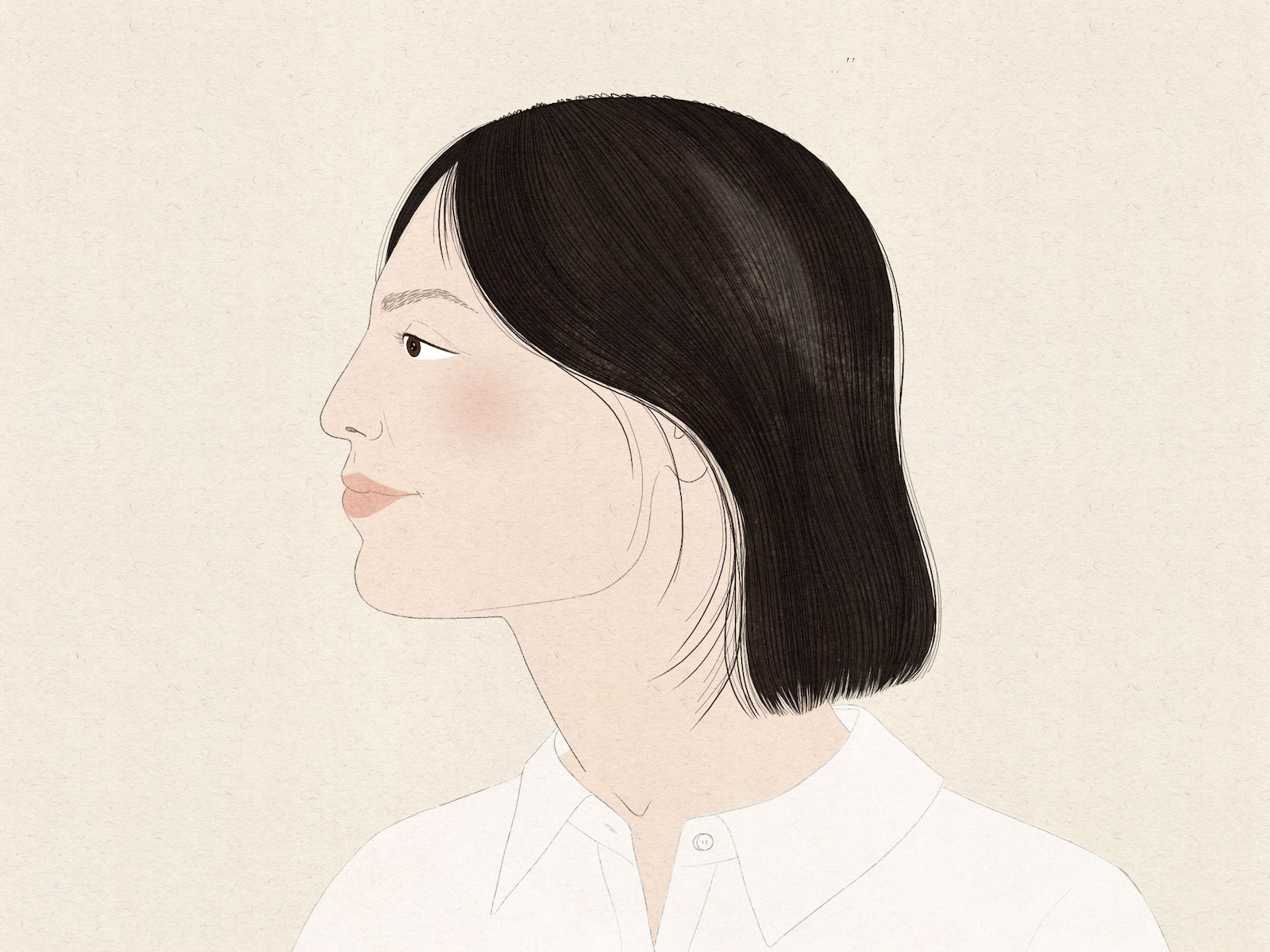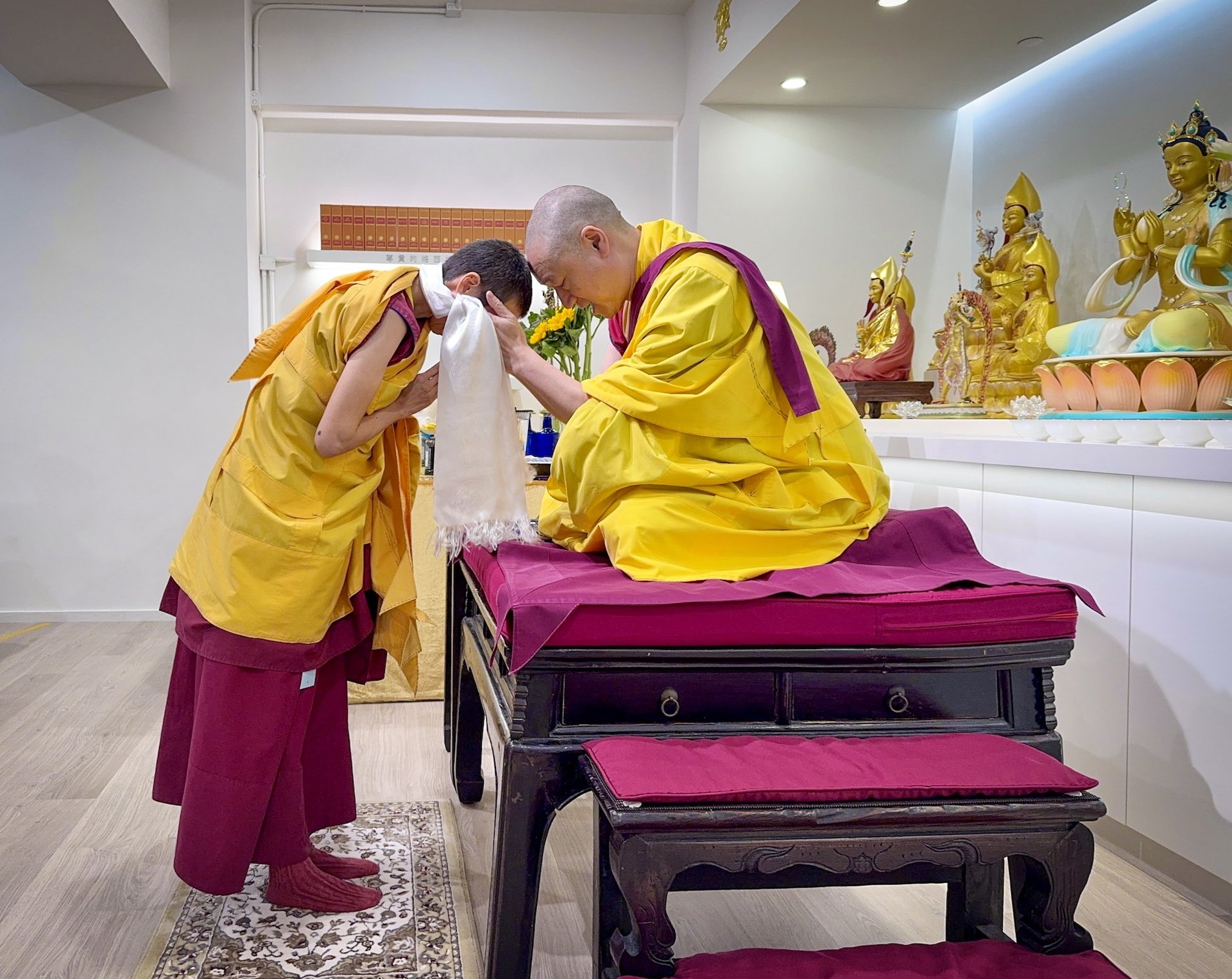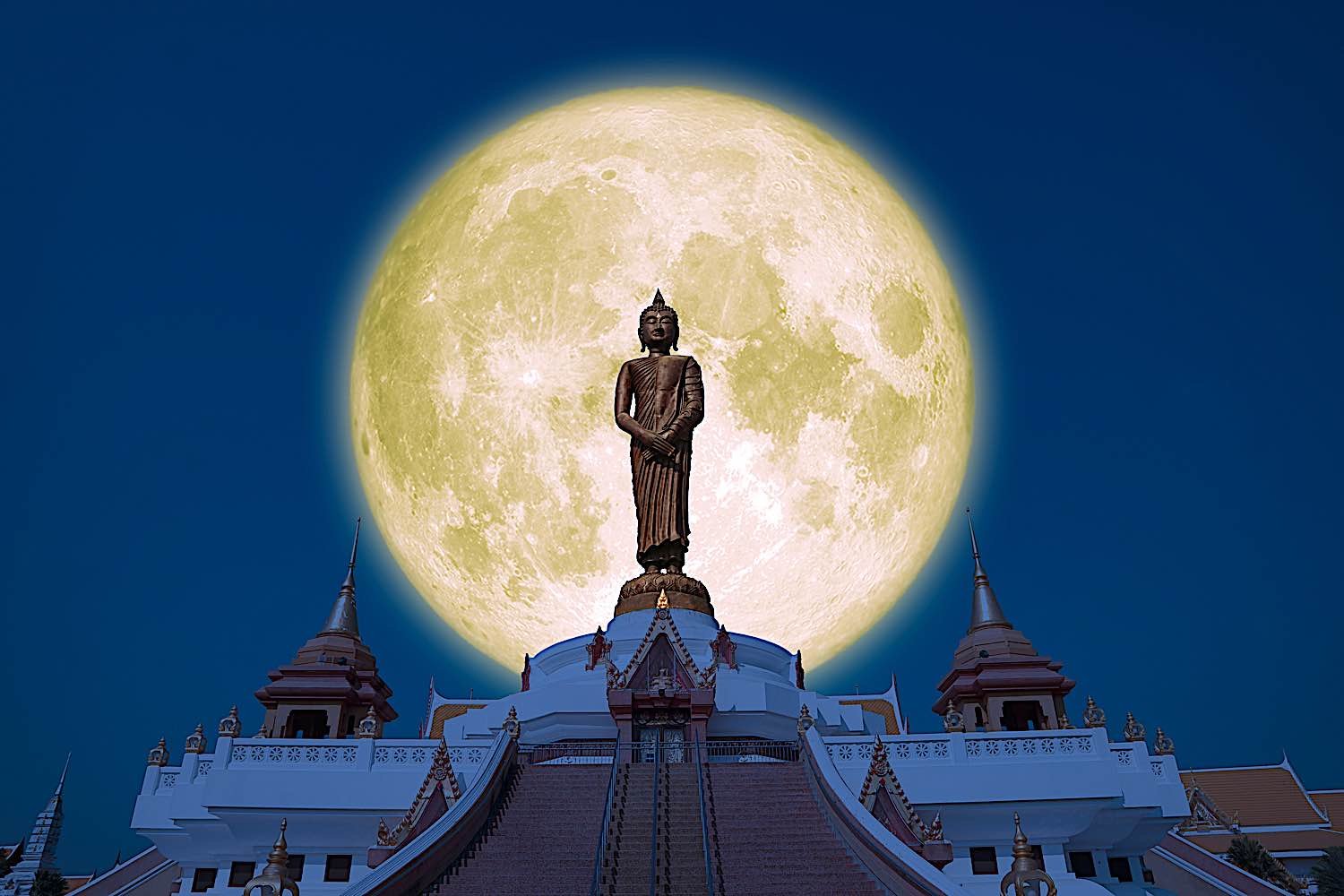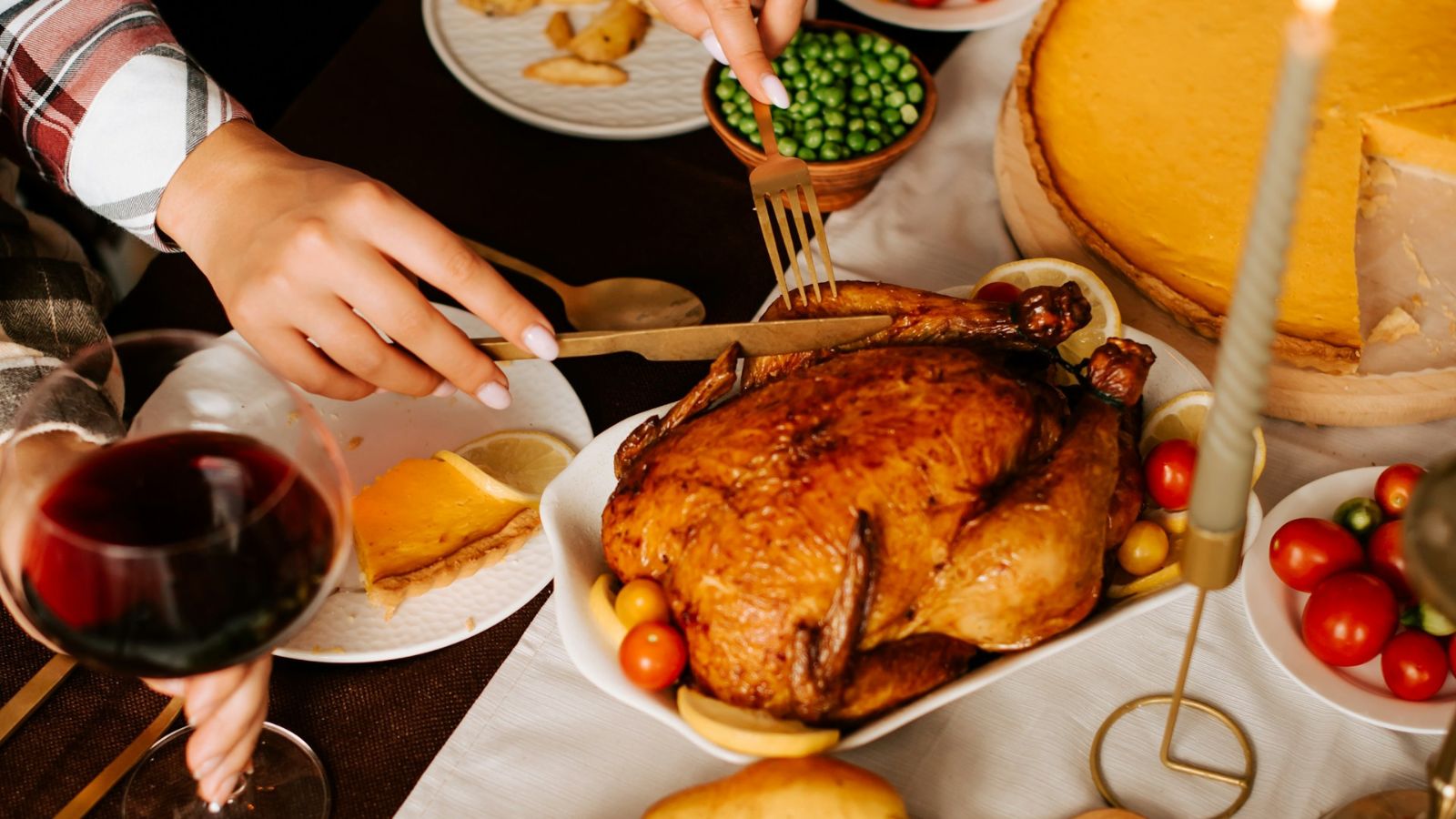Celebrating the Supreme Assembly, the Sangha: Maga Pug Day and Fourfold Assembly Day
Magha Puja Day is also known as Sangha Day or Fourfold Assembly Day in especially in Thailand, Laos and Cambodia where it is a public holiday. It is celebrated on the first full moon day of the month of...

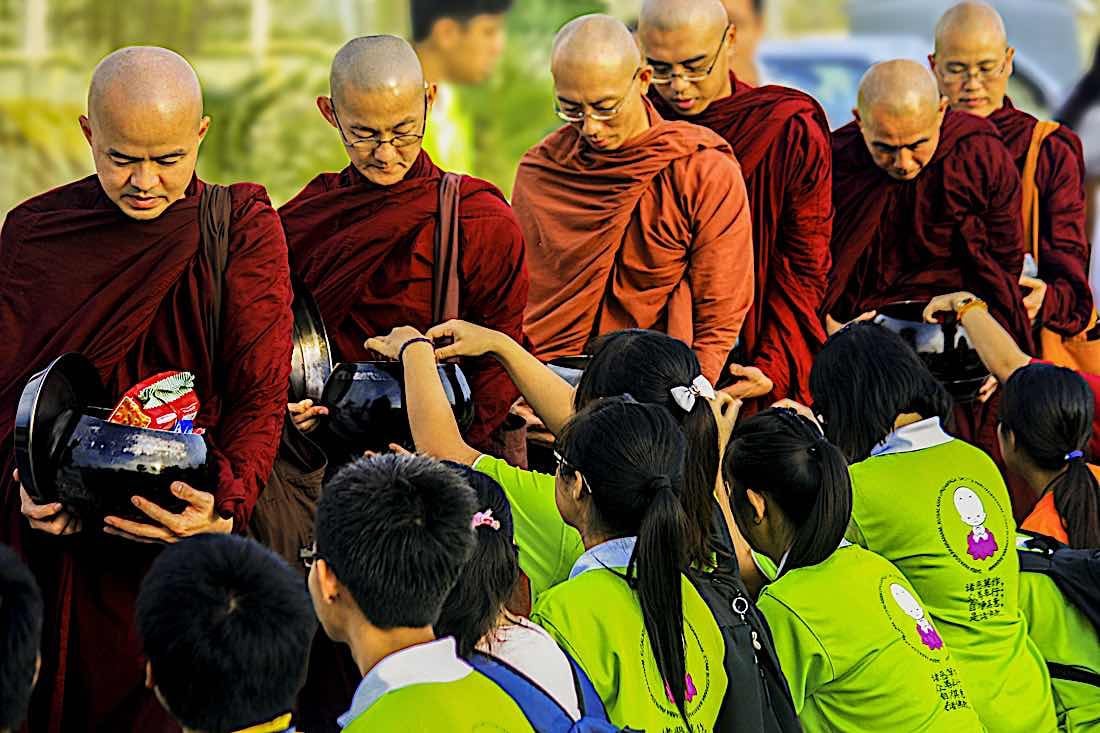 Youth give “dana” to monastic Sangha, a meritorious action.
Youth give “dana” to monastic Sangha, a meritorious action.Magha Puja Day is also known as Sangha Day or Fourfold Assembly Day in especially in Thailand, Laos and Cambodia where it is a public holiday. It is celebrated on the first full moon day of the month of Magh, which tends to fall in the Gregorian months of January or February. The day honors the assembly of 1,250 Buddhists who came together to pay their respect to the Buddha. It is a time for renewing our commitments to Buddha, Dharma and Sangha.
Māgha Pūjā (also written as Makha Bucha Day) is the second most important Buddhist festival after Vesak, celebrated on the full moon day of the third lunar month in Cambodia, Laos, Thailand, Sri Lanka and on the full moon day of Tabaung in Myanmar.
Reciting Sutra: Traditionally, the Sutra “Remembering the Three Jewels” is an especially auspicious and meritorious on Buddha days, including Maha Puja Day:
Sutra Remembering the Three Jewels – Meritorious Recitation for Buddha Days and to Purify Karma (6-Minute English Recitation):
Reciting Sutras — Highly Meritorious on Buddha Days!
Among the most auspicious and meritorious of practices on Buddha Days is recitation of Sutras. This can be in Sanskrit, Pali, Tibetan, English, or any language.
Two of the most meritorious are the Sutra Remembering the Three Jewels and the Heart Sutra. We have recitations as videos in English and Sanskrit embedded throughout this feature, starting with the Sutra Remembering the Three Jewels, which is recommended by Lama Zopa for Buddha Days:
Don’t miss the verified timeline of Shakyamuni Buddha’s life in the section below “Buddha’s Life” with dates or in the video below:Extra merit for practices on Buddha Days
On Buddha Special Days, such as Sangha, we celebrate by doing extra practices and dedication for the benefit of all beings. This can include reciting sutras, making offerings to the Sangha, practicing bodhichitta — the mind of awakening — and giving charity.
The practices outlined below are mostly Mahayana Sutras and practices. Theravada Buddhists would certainly read Pali Sutta, make offerings to the Sangha, and take lay precepts.
1. Chanting Sutras [Why reciting sutras out loud is important feature>>]
2. Making Offerings to Sangha
3. Practicing Bodhichitta [For a feature on Bodhichitta, see>>]
4. Giving Charity
5. Taking the Eight Mahayana Precepts
6. Doing a Water Bowl Offering Ceremony. [For a feature on Water Bowl practices, see>>]
7. Developing the Paramita of Wisdom by Studying Dharma Texts
8. Doing Prostrations to the Buddha or Taking Refuge in the Three Jewels. [Why taking refuge is important>>]
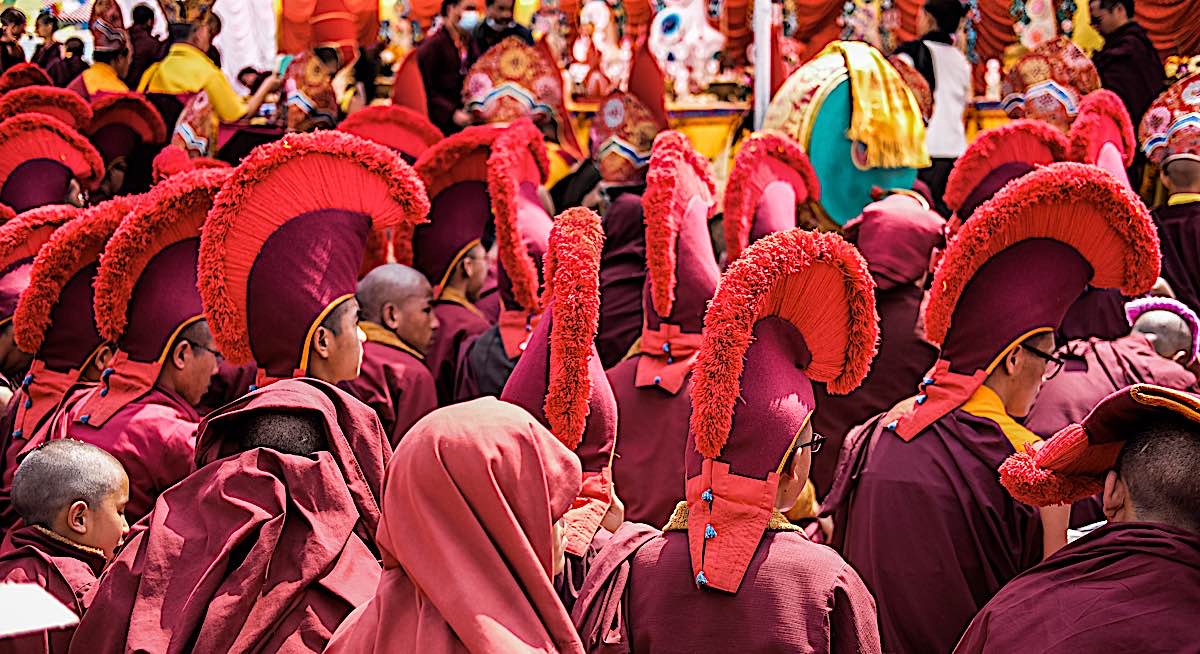 Monks celebrating Holy Day near Boudanath Stupa in Nepal Kathmandu.
Monks celebrating Holy Day near Boudanath Stupa in Nepal Kathmandu.
1. Chanting Sutras
The recitation of certain sutras is believed to be very powerful on this day, such as The Sutra of Golden Light, The Heart Sutra and The Diamond Sutra. Chanting these texts can create tremendous merit and help purify negativities. You could also chant the teaching on the Eightfold Path — translated below in the section “Teaching on the Eightfold Path.”
It is a wonderful practice to chant short sutras, such as the magnificent Heart Sutra. Here’s a lovely Sangha chanting of the Heart Sutra by the Sangha of Khyentse Foundation, with Dzongsar Khyentse Rinpoche [For the Heart Sutra “chant along” text see Appendix: Heart Sutra below]:
2. Making Offerings to Sangha
On Chokhor Duchen, we remember the importance of the monastic order and make offerings to them. This can be done in many ways, such as offering food, clothes or money. It’s also important to remember that the offering doesn’t have to be material — it can be something as simple as offering a smile or lending a helping hand.
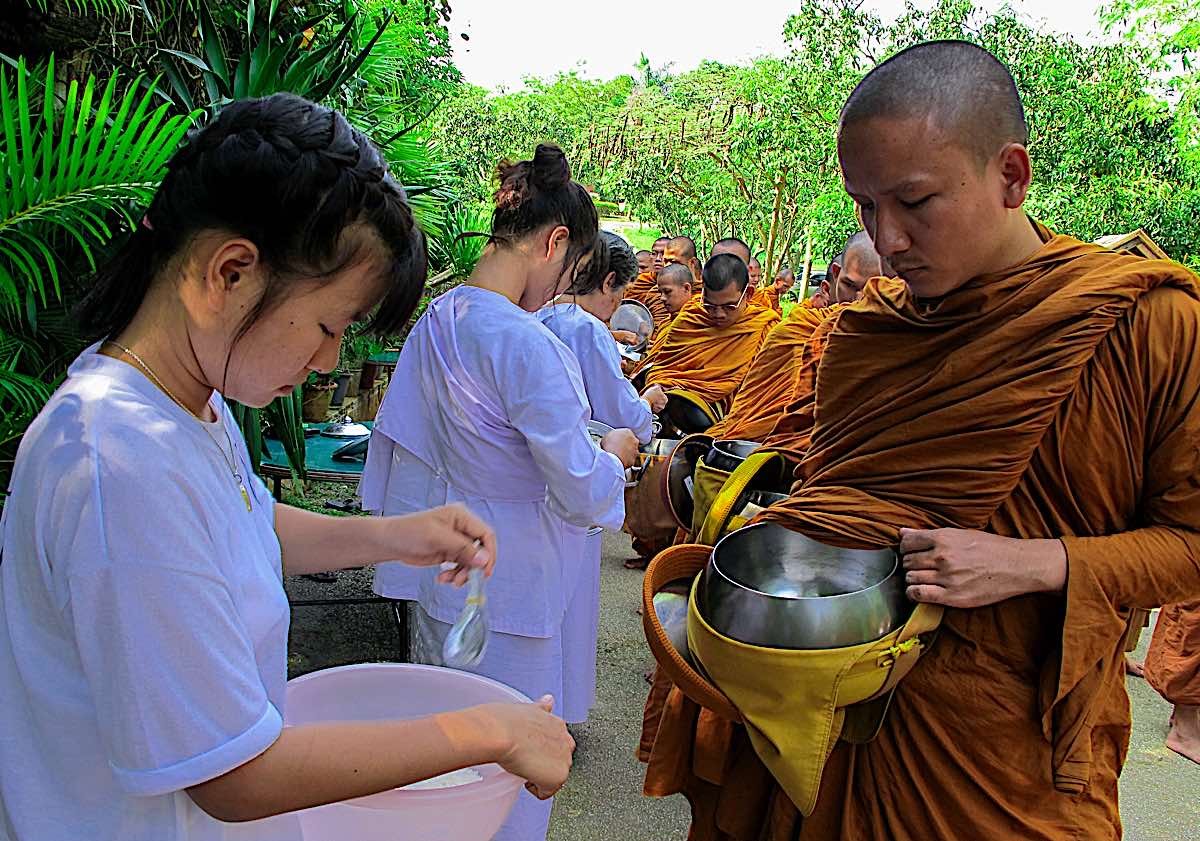 Offering food to the monastic Buddhist Sangha are among the most virtuous of offerings.
Offering food to the monastic Buddhist Sangha are among the most virtuous of offerings.
3. Practicing Bodhichitta
Bodhichitta is the mind of awakening, and on Chokhor Duchen we try to cultivate this precious attitude. There are many ways to do this, but one practice that is particularly effective is called “The Seven-Point Mind Training” (lojong in Tibetan). This practice helps us to develop compassion and love for all beings, even those who seem difficult to love.
For a feature on the King of Prayers and Bodhichitta>>Reciting the King of Prayers is a strong Bodhichitta practice (here in Sanskrit with English translations):
4. Giving Charity
On Chokhor Duchen, we remember the importance of giving and helping those in need. This can be done in many ways, such as giving money, food or clothes to those who are less fortunate. It’s also important to remember that charity doesn’t have to be material — it can be something as simple as offering a kind word or lending a helping hand.
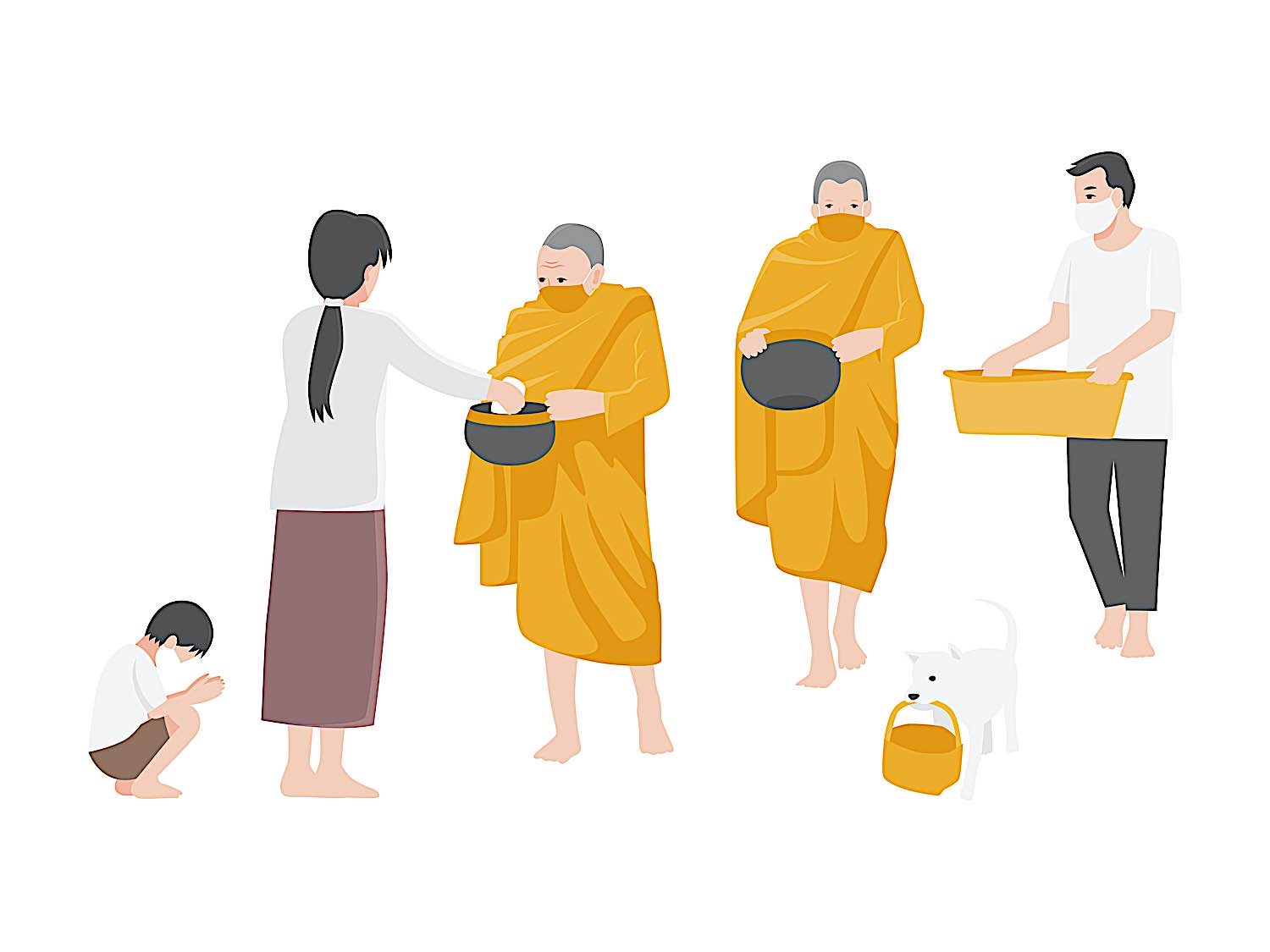 Generosity and giving have been a key practice in Buddhism since Buddh’a s First Teaching around 528 B.C. Here a lay Buddhist give sfood to monks who eat only one meal a day.
Generosity and giving have been a key practice in Buddhism since Buddh’a s First Teaching around 528 B.C. Here a lay Buddhist give sfood to monks who eat only one meal a day.
5. Taking the Eight Mahayana Precepts for the Day
The Eight Mahayana Precepts are a set of guidelines for ethical living, and on Chokhor Duchen we take them especially seriously. This is because the precepts help us to purify our negativities and cultivate positive actions. Taking the precepts is an excellent way to make our Chokhor Duchen celebration more meaningful. Lay practitioners normally follow five lay precepts, but on Holy Days, it is recommended to follow all eight. [For a feature on the Eight Precepts, see “Precepts for the Holy Day” section below.]
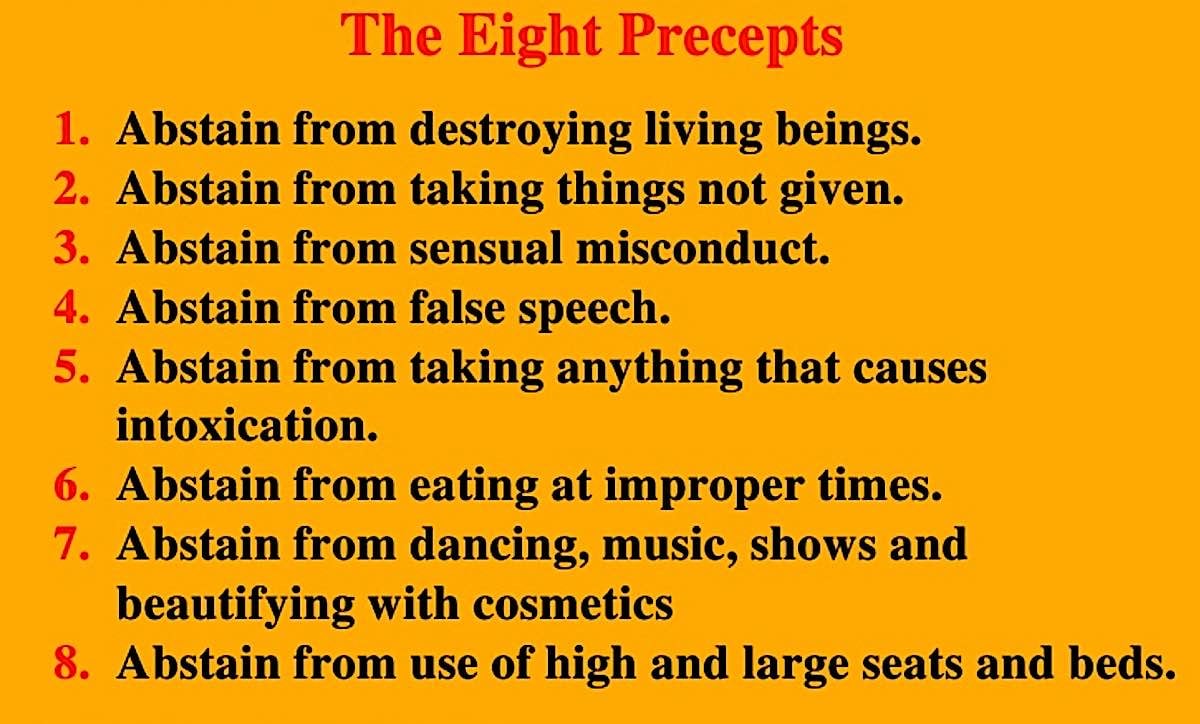 During purification retreats we undertake the eight wider Mahayana Precepts.
During purification retreats we undertake the eight wider Mahayana Precepts.
6. Doing a Water Bowl Offering Ceremony
A water bowl offering ceremony is a practice in which we offer water to the Buddhas and bodhisattvas. This practice helps us to purify our negativities and accumulate merit. It’s also a great way to show our respect for the Three Jewels. [For a feature on water bowl offering and its benefits, see>>]
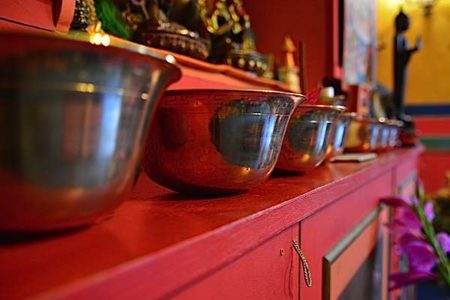 Water bowl offerings in front of image of Buddha.
Water bowl offerings in front of image of Buddha.
7. Developing the Paramita of Wisdom by Studying Dharma Texts
The paramita of wisdom refers to the perfection of wisdom, and on Chokhor Duchen we especially focus on developing this quality. One way to do this is by studying Dharma texts. This helps us to understand the teachings of the Buddha and put them into practice in our own lives. One text to study, of course, on his day, would be the Prajnaparamita Sutras themselves, and especially the short Heart Sutra.
For a feature on the Heart Sutra, see>> Heart Sutra text>> For a feature on the benefits or reading sutras out loud, see>>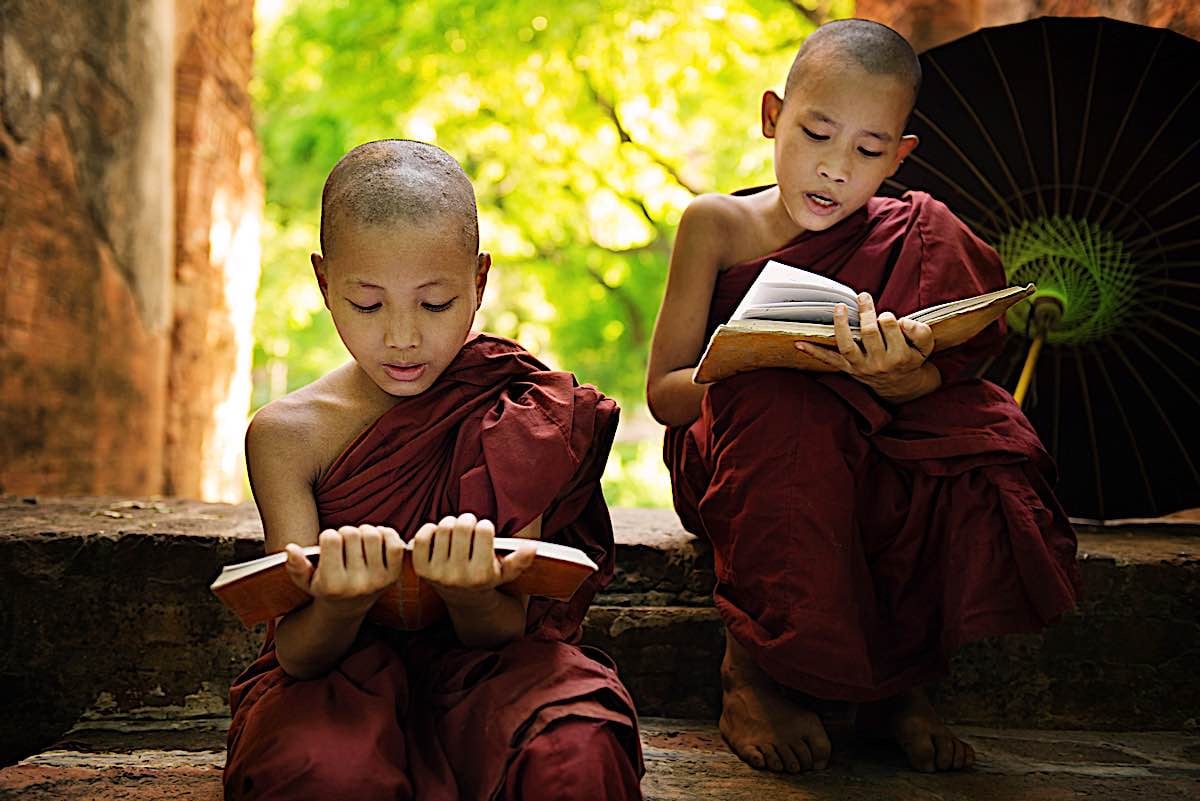 Two young monks recite sutras out loud, a meritorious practice.
Two young monks recite sutras out loud, a meritorious practice.8. Doing Prostrations to the Buddha or Taking Refuge in the Three Jewels
On Chokhor Duchen, we remember the importance of taking refuge in the Three Jewels — the Buddha, Dharma and Sangha. This can be done in many ways, but one particularly effective way is by doing prostrations to the Buddha. Prostrating helps us to develop a sense of respect and humility, which are essential qualities for taking refuge in the Three Jewels.
Taking Refuge and Bodhichitta (daily practice, but extremely meritorious on Buddha Day) chanted in Tibetan by Yoko Dharma:
No matter what you do on Chokhor Duchen, the most important thing is to remember the spirit of the day — to benefit others and yourself. By practicing bodhichitta and living in accordance with the precepts, we can create tremendous merit and make our Chokhor Duchen celebration truly meaningful.
No time for other practices? Chant Shakyamuni’s mantra
If you have no time for other practices, throughout the day, simply chant Shakyamuni Buddha’s mantra, while keeping your mind focused on the Great Conqueror. Of course, ideally, on such a Holy Day, more extensive practices are recommended.
Shakyamuni Mantra Video
Here is a beautiful Sanskrit version, 1 hour of full chanting of Shakyamuni Buddha’s Mantra. The mantra is
Om Muni Muni Mahamuni Shakyamuni Svaha
This translates as “Homage to the Sage, the Sage, the Great Sage Shakyamuni, Well Said.” and is considered a highly meritiorious practice. If we combine with prostrations, or accumulations of mantras for dedication of the merit for the benefit of all sentient beings, it is considered the most precious of practices:
Here’s is a beautiful video with chanting of the mantra in Tibetan Style (Soha instead of Svaha) by the amazing Yoko Dharma:
The Precepts for the Holy Day
Any day, a devout practicing Buddhist tries to observe the five precepts — ideally recite them aloud, then follow them for the day at least:
“I undertake the training-precept to abstain from onslaught on breathing beings.” (Pali: Pāṇātipātā veramaṇī sikkhāpadaṃ samādiyāmi.) “I undertake the training-precept to abstain from taking what is not given.” (Pali: Adinnādānā veramaṇī sikkhāpadaṃ samādiyāmi.) “I undertake the training-precept to abstain from misconduct concerning sense-pleasures.” (Pali: Kāmesumicchācāra veramaṇī sikkhāpadaṃ samādiyāmi.) “I undertake the training-precept to abstain from false speech.” (Pali: Musāvādā veramaṇī sikkhāpadaṃ samādiyāmi.) “I undertake the training-precept to abstain from alcoholic drink or drugs that are an opportunity for heedlessness.” (Pali: Surāmerayamajjapamādaṭṭhānā veramaṇī sikkhāpadaṃ samādiyāmi.)However, the devout Buddhist who is a lay practitioner — on days such as Wesak — usually tries to observe the Eight Precepts of ordained Buddhists for the day, as training in morality and humility.
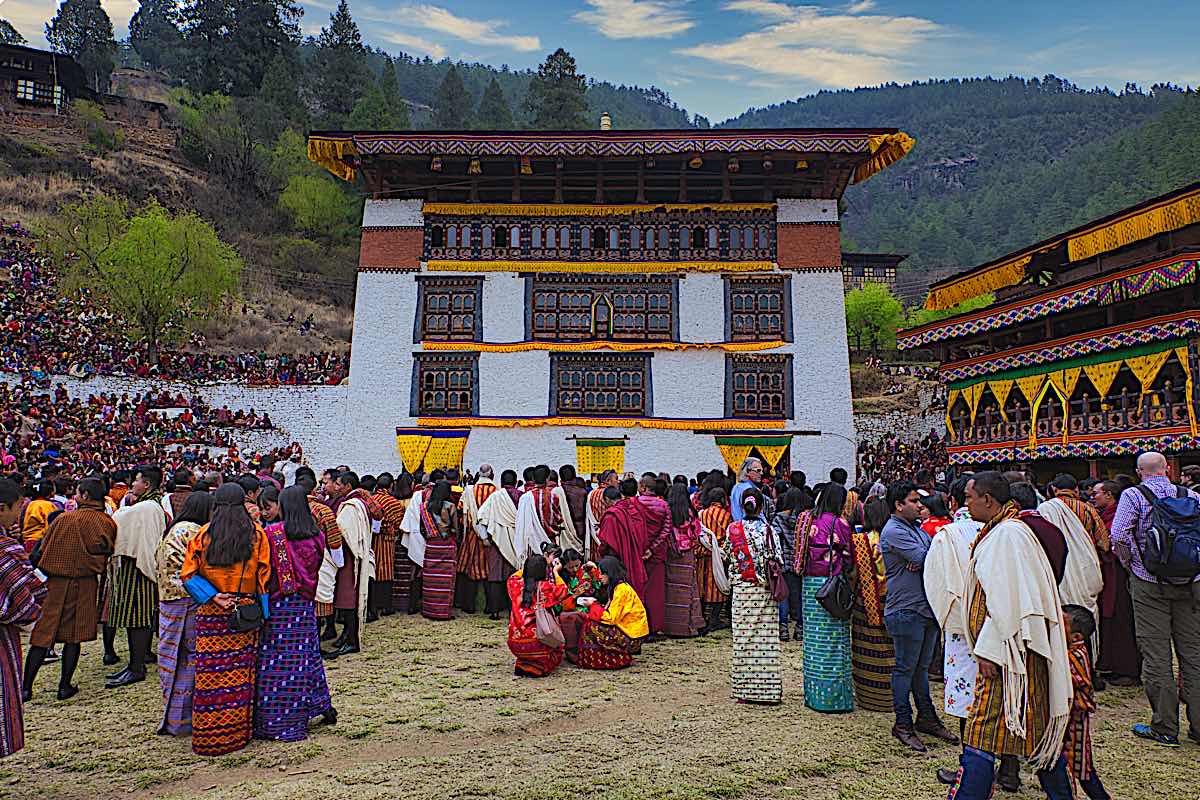 Festival day in Bhutan.
Festival day in Bhutan.
The remaining three precepts
The remaining three precepts, for special days (or ordained practitioners all of the time), would be:
6. I undertake to abstain from eating at the wrong time — the correct time is after sunrise but before noon.
7. I undertake to abstain from singing, dancing, playing music, attending entertainment performances, wearing perfume, and using cosmetics and garlands or decorations.
8. I undertake to abstain from luxurious places for sitting or sleeping, and overindulging in sleep.
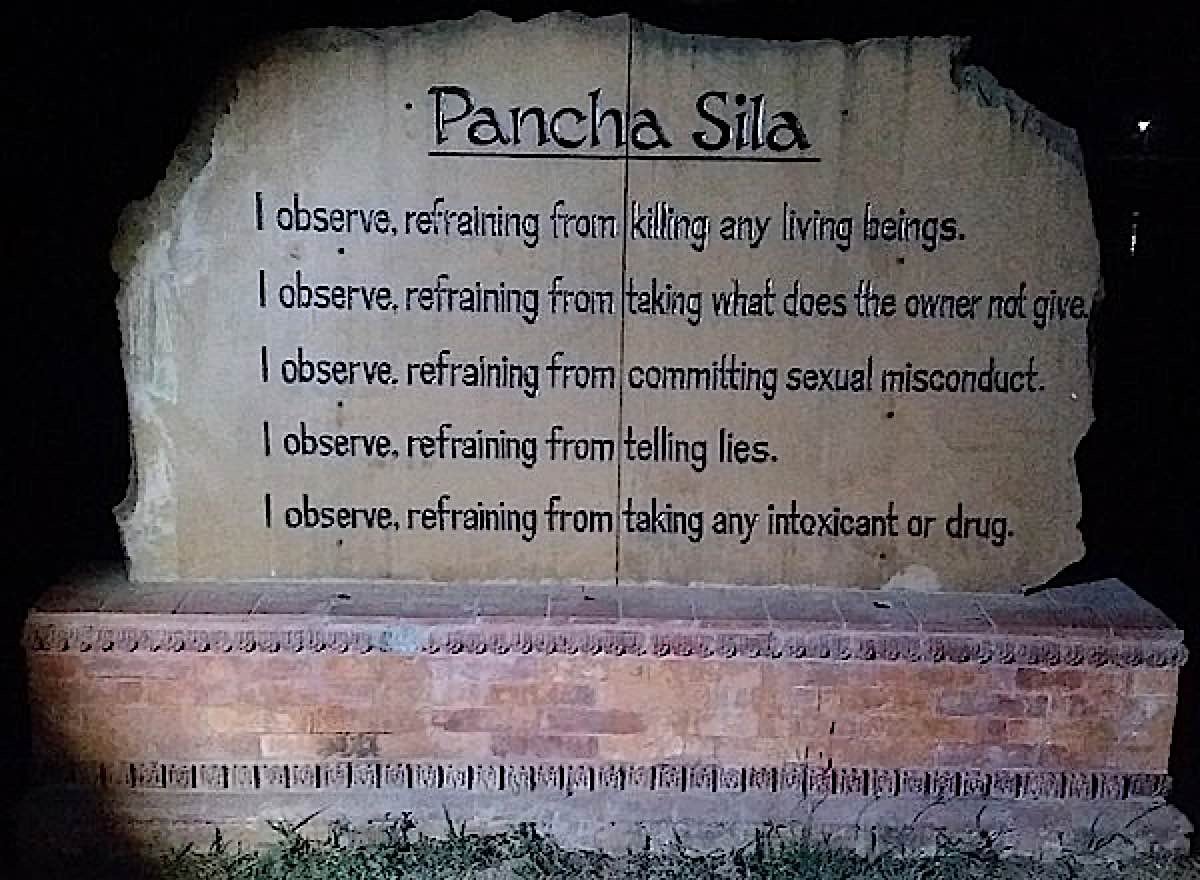 Plaque with the five precepts engraved in Lumbini Park, Nepal.
Plaque with the five precepts engraved in Lumbini Park, Nepal.
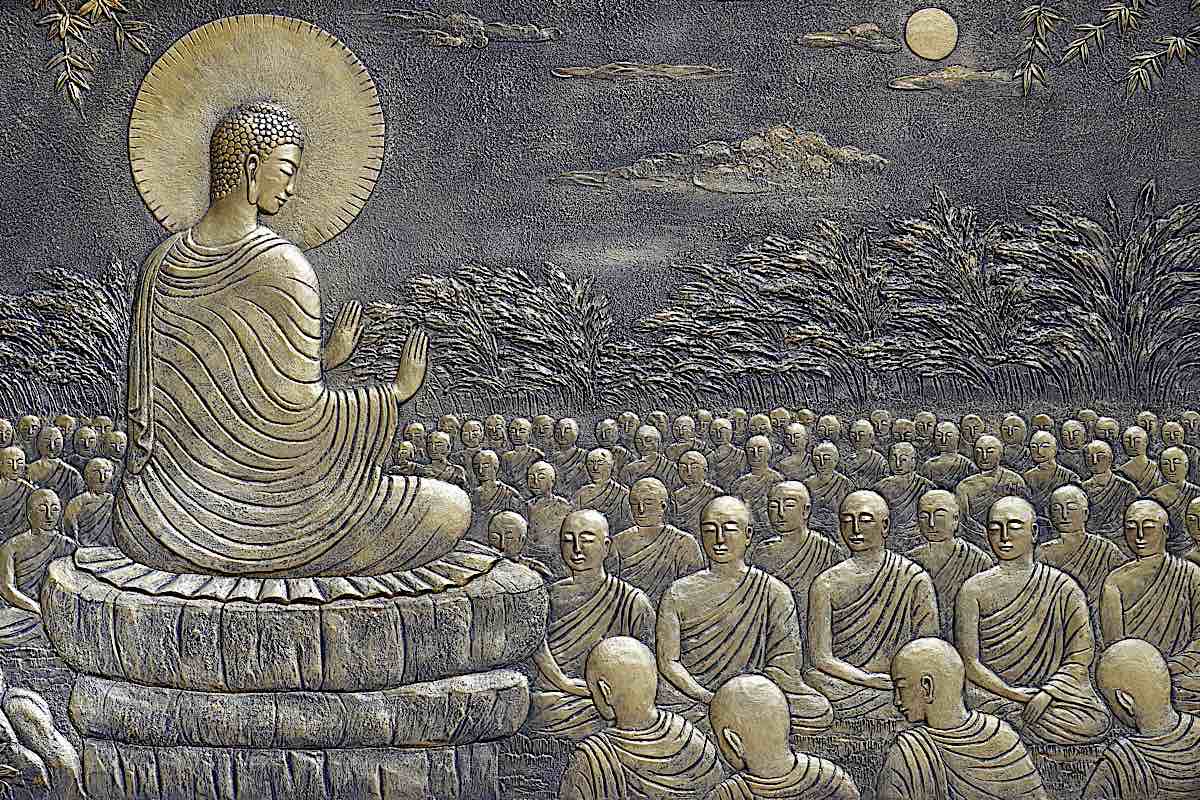 Chokyur Druchen honors the day Buddha first Turned the Wheel of Dharma. Relief of Buddha teaching in Vietnam temple.
Chokyur Druchen honors the day Buddha first Turned the Wheel of Dharma. Relief of Buddha teaching in Vietnam temple.Timeline of Buddha’s Life
Although earlier experts placed Buddha’s life at 490 B.C. to 410 B.C., the latest archeological evidence places Buddha’s Birth at 563 B.C. and his Paranirvana at 483 B.C. Dating relates to birth relics recently found, and his Paranirvana dates can be easily reinforced by his funeral relics scattered throughout India and Asia.
 Stupa drum panel showing the conception of the Buddha: Queen Maya dreams of white elephant entering her right side. Wiki Commons.
Stupa drum panel showing the conception of the Buddha: Queen Maya dreams of white elephant entering her right side. Wiki Commons.
563 B.C. Conception to the Sakyas
Sakyamuni (Shakyamuni) Gautama Buddha’s conception — in much of Asia, conception is the celebratory date, rather than the actual date of birth. [2] Famously, Queen Maha Maya, Buddha’s mother, had a conception dream of a white elephant with six tusks descending from heaven to enter her womb. His title Sakyamuni (pronounced Shakyamuni) literally means ‘sage’ of the Sakyans — where Sakya was his father’s kingdom or oligarchic republic (located in modern-day Nepal). Muni literally means “sage.” Śākyamuni (शाक्यमुनि) is title of Buddha fist cited in Mahāprajñāpāramitāśāstra (chapter VI).
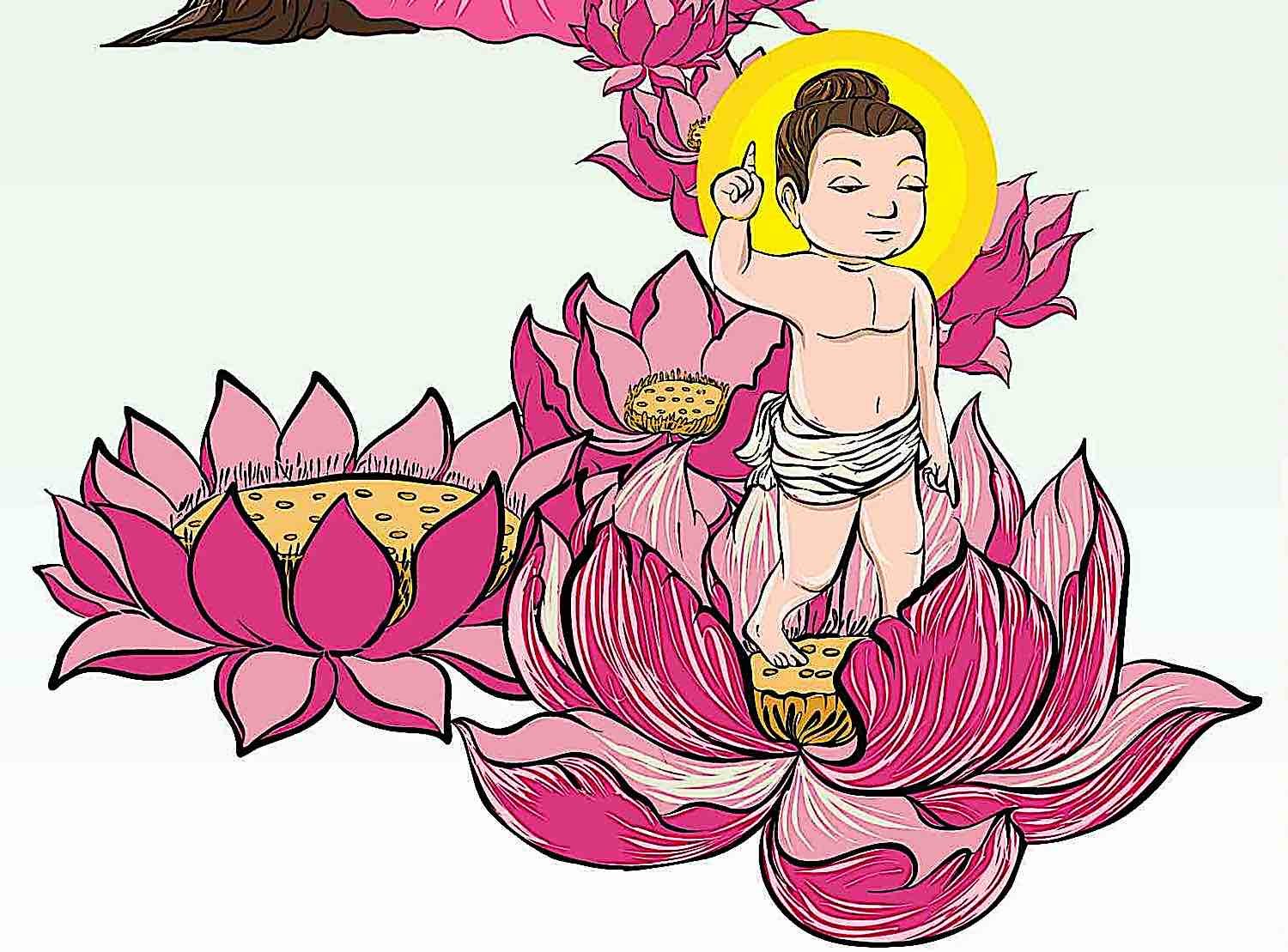 According to legend, Baby Buddha took seven steps to each of the directions immediately after his miraculous birth.
According to legend, Baby Buddha took seven steps to each of the directions immediately after his miraculous birth.
563 B.C. Siddartha’s Birth in Lumbini Nepal
Buddha was actually born Prince Siddartha, in Lumbini Nepal. According to tradition:
“Buddha emerged from his mother’s side, as she stood leaning against a tree, in a painless and pure birth.” [2]
He was named Siddartha (or Sarvathasiddha) — literally meaning “a man who achieves his goals” — by his father the king, who was determined he would be a great worldly king and conqueror, not a Buddha as predicted by the sages. His mother passed away, and he was brought up by his aunt Mahaprajapati.
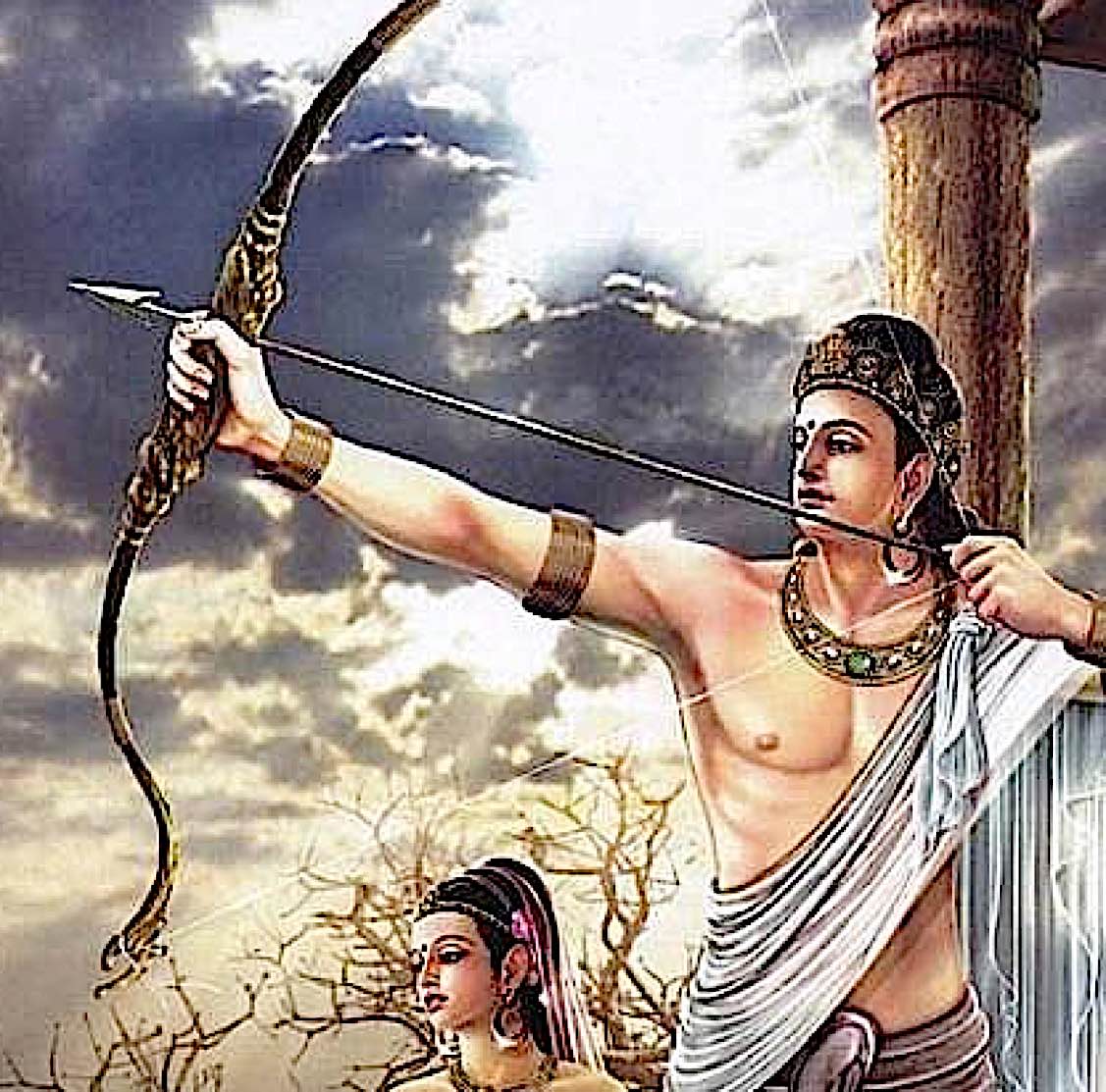 Siddartha Buddha grew up in the palace and was an expert in martial arts.
Siddartha Buddha grew up in the palace and was an expert in martial arts.
548 B.C. Siddartha’s marriage to Yasodhara
His father the king determined he must be sheltered from the suffering of the world to remove any causes that might arise compassion in the young prince. True to his father’s aspirations, he was brought up a privileged prince, sequestered in the palace. He was married to young Yasodhara, who conceived their son Rahula.
Siddartha grew up in Kapilavastu, the capital, and became very accomplished in “kingly arts” including the martial arts.
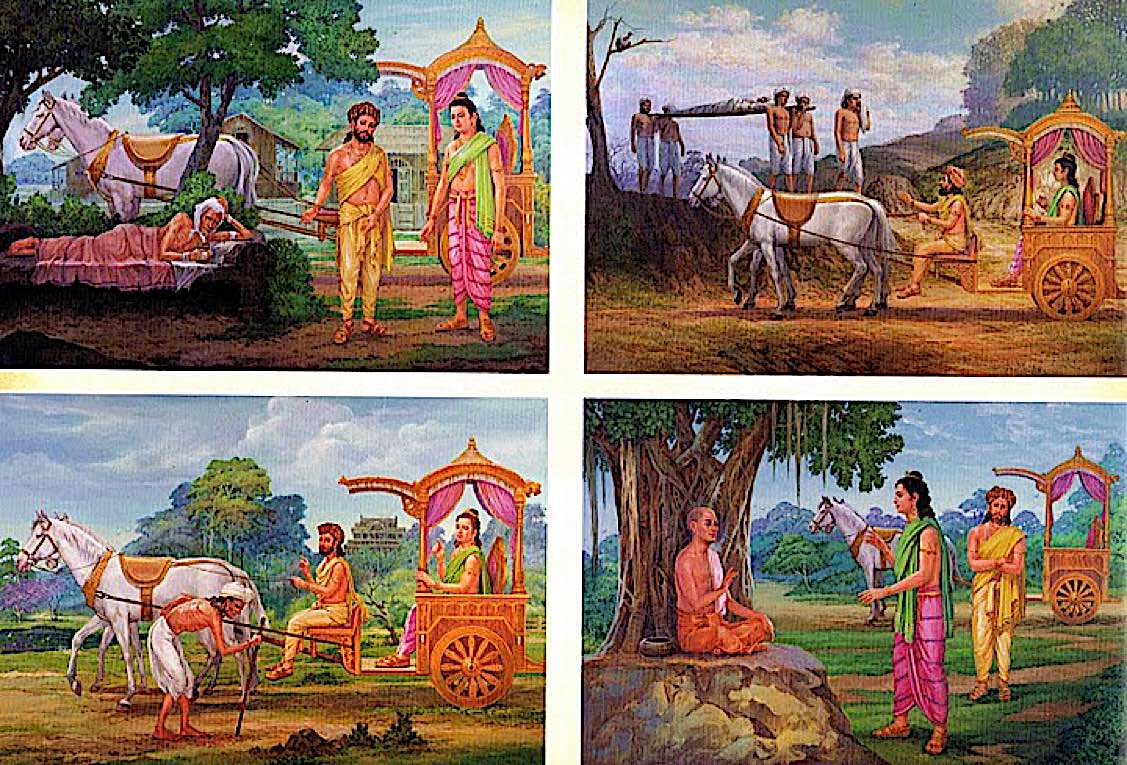 Siddartha leaves the palace and sees the four sights: poverty, illness, old age and death.
Siddartha leaves the palace and sees the four sights: poverty, illness, old age and death.
534 B.C. Buddha sees the four sights: suffering
True to predictions of the sages — and despite his father’s fiercely protective tactics — Prince Siddartha escaped the palace and saw the four sights of suffering: poverty, illness, old age, and death. He also saw religious ascetics. His “existential crisis” [2] led to his life’s mission — to release the world from all suffering.
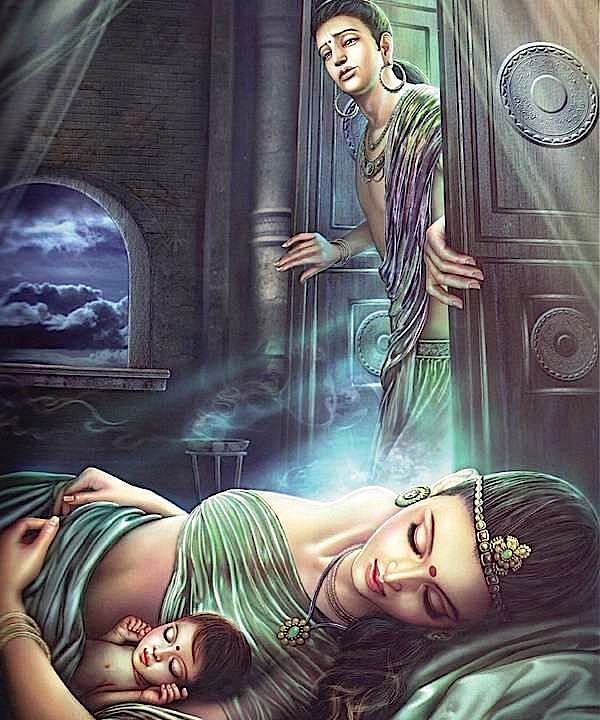 Buddha determines to leave his wife Yasodhara and son Rahula to seek Enlightenment — to release them from ultimate suffering in Samsara. Later, they both become his followers.
Buddha determines to leave his wife Yasodhara and son Rahula to seek Enlightenment — to release them from ultimate suffering in Samsara. Later, they both become his followers.
534 B.C. Siddartha leaves home
With compassion awake in the young Prince Siddartha, he became driven to overcome the suffering of Samsara. In a dramatic moment, Siddartha determined to leave home — quietly leaving the palace to avoid his father’s guards. He knew he must abandon his conventional, privileged life, to seek the answers that would save all beings from the eternal cycle of suffering.
Dramatically, he left his beloved wife and child — knowing he must for the ultimate benefit — cut his hair and left behind even his inseparable horse. Cutting his hair was a symbol of leaving behind his ordinary life. He traveled south, seeking out other spiritual seekers, and ended in Magadha (current Bihar) where he begged on the streets.
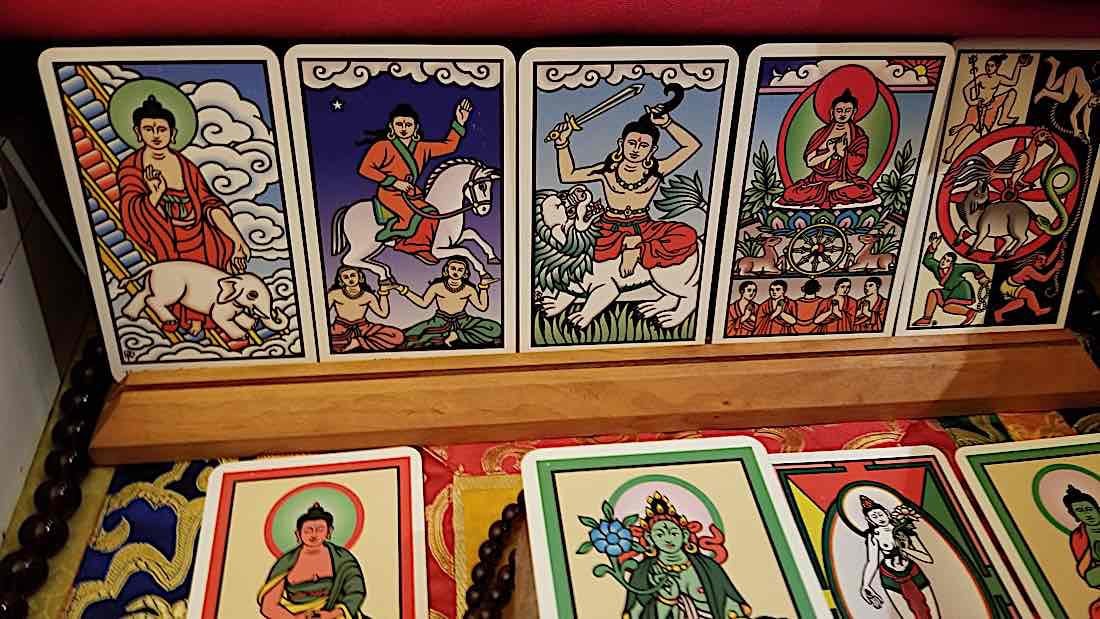 Buddha Tarot by Robert Place features the life and journey to Enlightenment of Siddartha Buddha as the major Aracana, in place of the “fool’s journey” to spiritual enlightenment. On the top (left to right) are the white elephant that descended to Queen Maha in the conception dream, Siddartha leaving the palace on his horse, Siddartha cutting his hair to become an ascetic, then Buddha’s first sermon.
Buddha Tarot by Robert Place features the life and journey to Enlightenment of Siddartha Buddha as the major Aracana, in place of the “fool’s journey” to spiritual enlightenment. On the top (left to right) are the white elephant that descended to Queen Maha in the conception dream, Siddartha leaving the palace on his horse, Siddartha cutting his hair to become an ascetic, then Buddha’s first sermon.533 B.C. Siddartha Meditates in Magadha
Like most spiritual seekers, Siddartha sought out and trained with many meditation teachers — notably “the masters Ālāra Kālāma and Uddaka Rāmaputta” [2]
He learned and mastered with the best of the great sages of the time, attaining great realizations, but not the ultimate solution. He determined they did not have the final “permanent” solution, and decided he must seek the solution on his own.
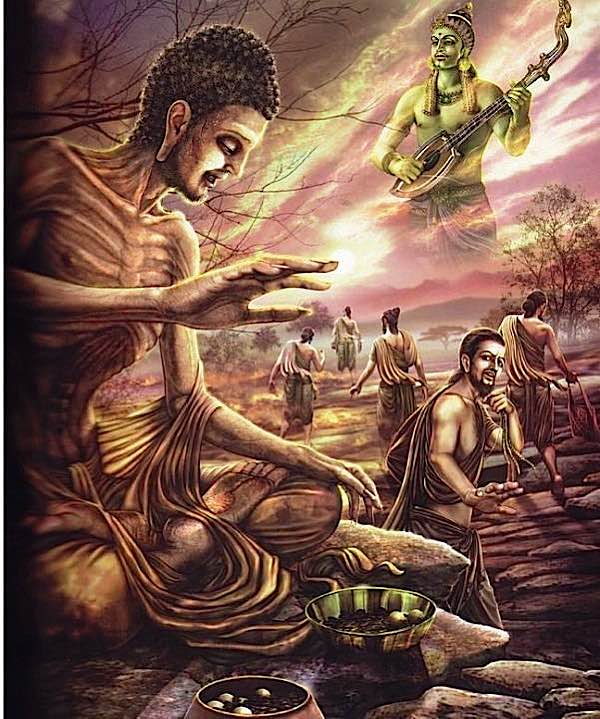 Buddha as the ascetic. Buddha starved himself eating only a grain of rice a day, seeking the answers through the ancient practices of asceticism.
Buddha as the ascetic. Buddha starved himself eating only a grain of rice a day, seeking the answers through the ancient practices of asceticism.
532-5238 B.C. Siddartha the Ascetic
Asceticism was an extreme form of practice that included living in the wild without protection, extreme fasting — basically, an attempt to “down the physical influence of one’s being and release the soul, an insubstantial essence in each individual.” [2]
He continued this until he was nothing but dry skin and bones, close to death.
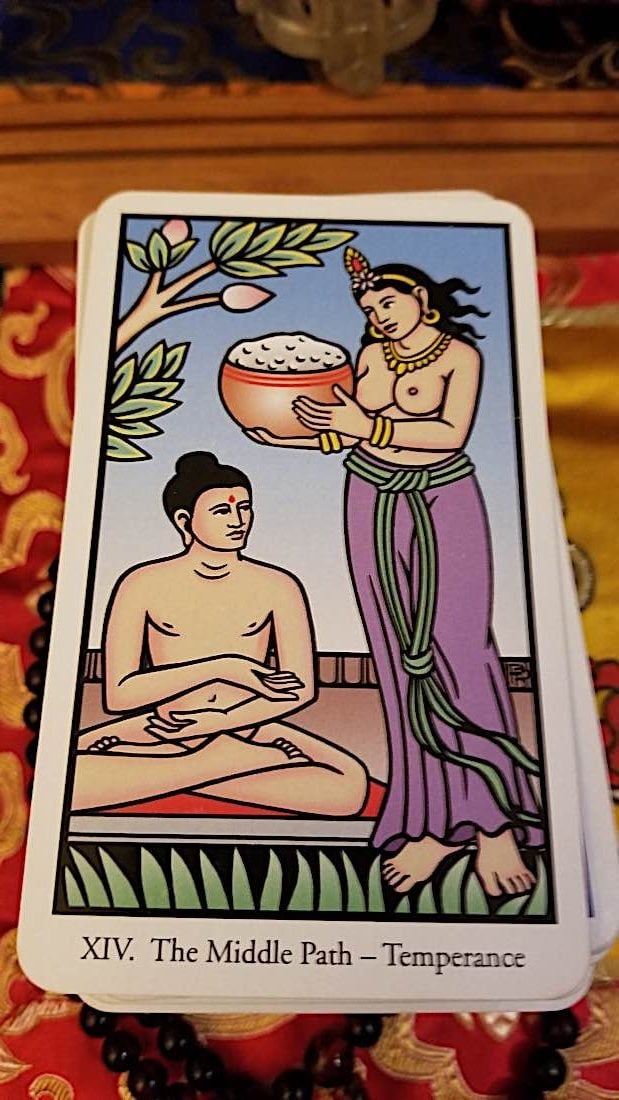 In Robert Place’s stunning Buddha Tarot, card XIV illustrates the moment of insight of the Buddha, after he had endured starvation and ascetic practices, that the “middle way” is the path to Enlightenment. Here, he is offered a bowl of rice at just that moment.
In Robert Place’s stunning Buddha Tarot, card XIV illustrates the moment of insight of the Buddha, after he had endured starvation and ascetic practices, that the “middle way” is the path to Enlightenment. Here, he is offered a bowl of rice at just that moment.
528 B.C. Siddartha risks death at Varanasi
Pushing his practice to the extreme, he tried every extreme meditation and practice — together with five other ascetics — only to nearly die of starvation. Finally, he realized the “middle way” was the correct path to Enlightenment — neither the extreme of deprivation nor its opposite of luxury. Barely able to move, he accepted a tiny bowl of mik, rice from a devotee named Sujata. From that moment, he pioneered the “Middle Path” now known as “Buddhism.”
 Mara’s army is swept away by a flood of merits. The Earth Mother rings out her hair releasing the torrent. In each of Buddha’s many lifetimes as a compassionate Bodhisattva, he accumulated drops of merit — released now as an epic flood on the day of his Enlightenment.
Mara’s army is swept away by a flood of merits. The Earth Mother rings out her hair releasing the torrent. In each of Buddha’s many lifetimes as a compassionate Bodhisattva, he accumulated drops of merit — released now as an epic flood on the day of his Enlightenment.
528 B.C. Awakening at Bodh Gaya
At Buddhism’s most “famous” site, Bodhgaya, Siddartha found the liberating path. Rejected by the five ascetics, he ate modest meals, recovering his strength, then moved to a new meditation site under the most famous tree in history — the Pipal Tree of Bodh Gaya. [A decedent of this tree is still honored today in Bodhgaya.]
He withdrew into his mind, pioneering a new “middle way” of meditating. He endured trials under the tree, tempted by the Mara and his legions and armies. [Mara and his legions, assailing the Buddha under the tree, can be thought of as the struggle Buddha faced internally with his own attachments and past karmic imprints.] Finally, he awakened, and Mara and his legions vanished. Famously, the symbol of this is Buddha touching the earth as his witness. He attained Bodhi — Awakening — and became the Buddha, the Awakened One.
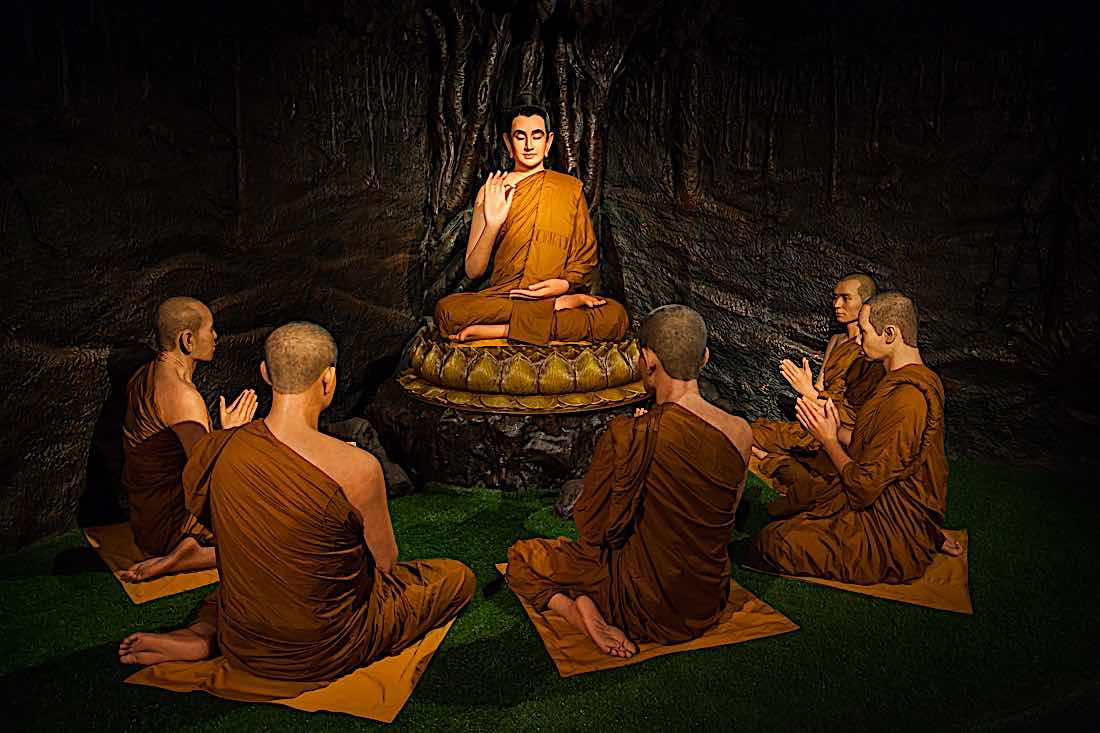 The Buddha teaching — his first teaching was on the Four Noble Truths.
The Buddha teaching — his first teaching was on the Four Noble Truths.
528 B.C. First Teaching at Sarnath
Buddha “turned the first wheel” of teaching, determined to help others with his perfect methods. His first pupils were the five ascetics who had earlier rebuked him. His first teachings were the Four Noble Truths, and the Eightfold Path:
Buddha first taught the Four Noble Truths, the Truth of Suffering, metaphorically, the “disease” we are treating.
“What, monks, is the truth of suffering? Birth is suffering, decay, sickness and death are suffering. To be separated from what you like is suffering. To want something and not get it is suffering. In short, the human personality, liable as it is to clinging and attachment brings suffering.” [3]
 Eightfold Path
Eightfold Path
Overcoming suffering relied on the Eightfold Path:
“This is the noble eightfold way, namely, right understanding, right intention, right speech, right action, right livelihood, right attention, right concentration, and right meditation.” — Shakyamuni Buddha at Deerpark
• For a feature on the Four Noble Truths and Eightfold Path, see>>
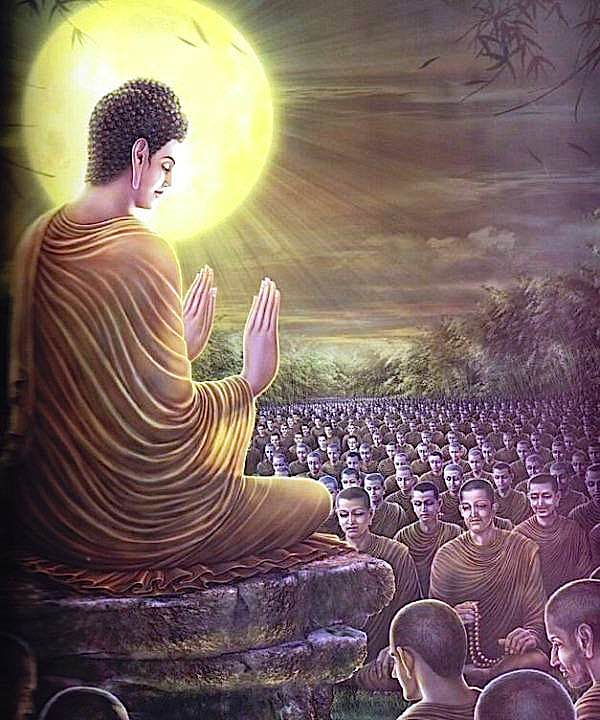 The Buddha continued to teach for 45 years to a growing group of committed monks and lay disciples.
The Buddha continued to teach for 45 years to a growing group of committed monks and lay disciples.
528-483 B.C. Countless teachings, Turning the Wheel
Buddha traveled with a growing entourage of disciples, teaching for the next 45 years. These precious teachings, recorded by his pupils, became a vast body of Pali Sutta, and later Mahayana Sutra — the largest collection of spiritual teachings in history. His teachings would spread throughout India, China, Japan, Korea, and all of Asia — and ultimately around the world.
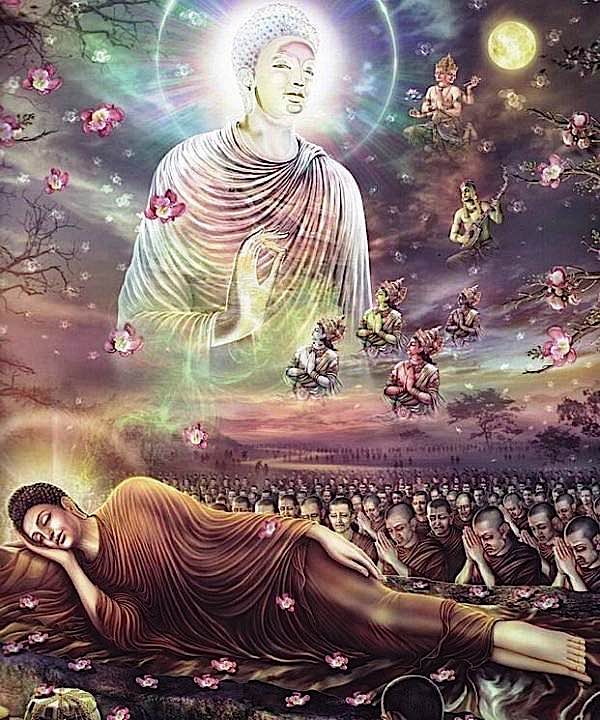 Shakyamuni Buddha practiced the eightfold path and taught it to his disciples. He attained Enlightenment.
Shakyamuni Buddha practiced the eightfold path and taught it to his disciples. He attained Enlightenment.
483 B.C. Paranirvana at Kusinagara, Malla
At the age of 80, he decided it was time for him to leave the teachings to his Sangha of disciples. He gave his last teaching. He asked his disciples if they had any last questions for him before he left.
Finally, he said, “Things that arise from causes will also decay. Press on with due care.”[3]
He lay down on his right side, with his hand under his face — in the pose made famous by the Sleeping Buddha statue — and passed into the peace of ultimate Paranirvana. [3]

 Aliver
Aliver 







